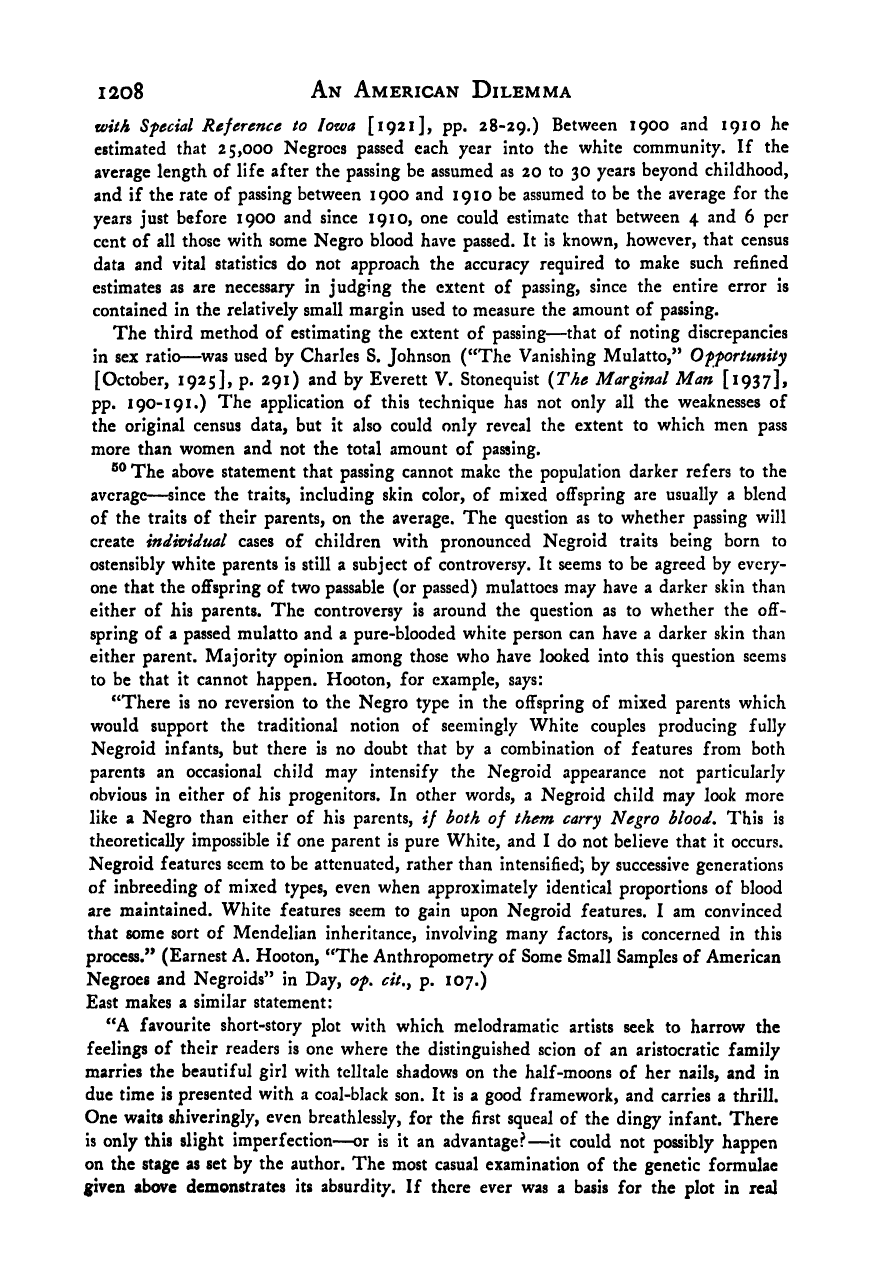Note: Gunnar Myrdal died in 1987, less than 70 years ago. Therefore, this work is protected by copyright, restricting your legal rights to reproduce it. However, you are welcome to view it on screen, as you do now. Read more about copyright.
Full resolution (TIFF) - On this page / på denna sida - Footnotes - Chapter 5

<< prev. page << föreg. sida << >> nästa sida >> next page >>
Below is the raw OCR text
from the above scanned image.
Do you see an error? Proofread the page now!
Här nedan syns maskintolkade texten från faksimilbilden ovan.
Ser du något fel? Korrekturläs sidan nu!
This page has never been proofread. / Denna sida har aldrig korrekturlästs.
i2o8 An American Dilemma
with Sfecid Reference to Iowa [1921], pp. 28-29.) Between 1900 and 1910 he
estimated that 25,000 Negroes passed each year into the white community. If the
average length of life after the passing be assumed as 20 to 30 years beyond childhood,
and if the rate of passing between 1900 and 1910 be assumed to be the average for the
years just before 1900 and since 1910, one could estimate that between 4 and 6 per
cent of all those with some Negro blood have passed. It is known, however, that census
data and vital statistics do not approach the accuracy required to make such refined
estimates as are necessary in judging the extent of passing, since the entire error is
contained in the relatively small margin used to measure the amount of passing.
The third method of estimating the extent of passing—that of noting discrepancies
in sex ratio—was used by Charles S. Johnson (“The Vanishing Mulatto,” Ofj>ortunity
[October, 1925], p. 291) and by Everett V. Stonequist {The Marginal Man [1937],
pp. 1 90- 1
9 1.) The application of this technique has not only all the weaknesses of
the original census data, but it also could only reveal the extent to which men pass
more than women and not the total amount of passing.
®®The above statement that passing cannot make the population darker refers to the
average—since the traits, including skin color, of mixed offspring are usually a blend
of the traits of their parents, on the average. The question as to whether passing will
create individual cases of children with pronounced Negroid traits being born to
ostensibly white parents is still a subject of controversy. It seems to be agreed by every-
one that the offspring of two passable (or passed) mulattocs may have a darker skin than
either of his parents. The controversy is around the question as to whether the off-
spring of a passed mulatto and a pure-blooded white person can have a darker skin than
either parent. Majority opinion among those who have looked into this question seems
to be that it cannot happen. Hooton, for example, says:
“There is no reversion to the Negro type in the offspring of mixed parents which
would support the traditional notion of seemingly White couples producing fully
Negroid infants, but there is no doubt that by a combination of features from both
parents an occasional child may intensify the Negroid appearance not particularly
obvious in either of his progenitors. In other words, a Negroid child may look more
like a Negro than either of his parents, if both of them carry Negro blood. This is
theoretically impossible if one parent is pure White, and I do not believe that it occurs.
Negroid features seem to be attenuated, rather than intensified’, by successive generations
of inbreeding of mixed types, even when approximately identical proportions of blood
are maintained. White features seem to gain upon Negroid features. I am convinced
that some sort of Mendelian inheritance, involving many factors, is concerned in this
process.” (Earnest A. Hooton, “The Anthropometry of Some Small Samples of American
Negroes and Negroids” in Day, of, cit,^ p. 107.)
East makes a similar statement:
“A favourite short-story plot with which melodramatic artists seek to harrow the
feelings of their readers is one where the distinguished scion of an aristocratic family
marries the beautiful girl with telltale shadows on the half-moons of her nails, and in
due time is presented with a coal-black son. It is a good framework, and carries a thrill.
One waits shiveringly, even breathlessly, for the first squeal of the dingy infant. There
is only this slight imperfection—or is it an advantage? —it could not possibly happen
on the stage as set by the author. The most casual examination of the genetic formulae
given above demonstrates its absurdity. If there ever was a basis for the plot in real
<< prev. page << föreg. sida << >> nästa sida >> next page >>